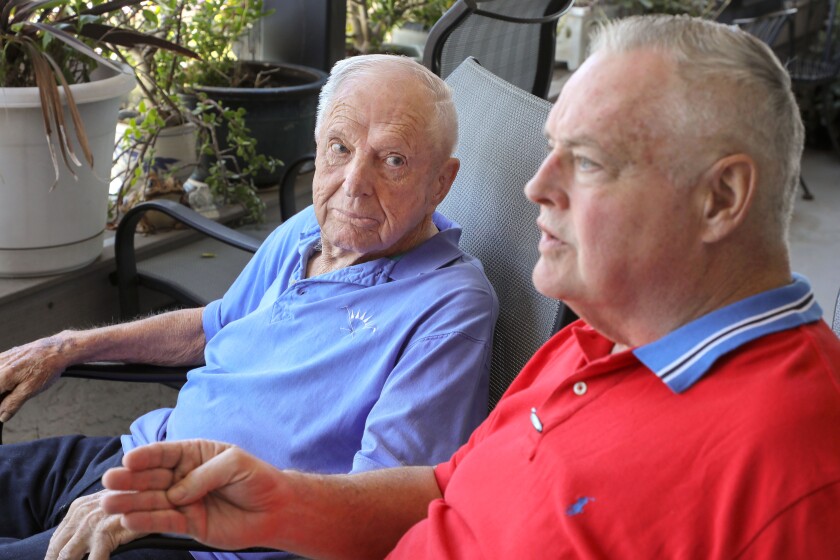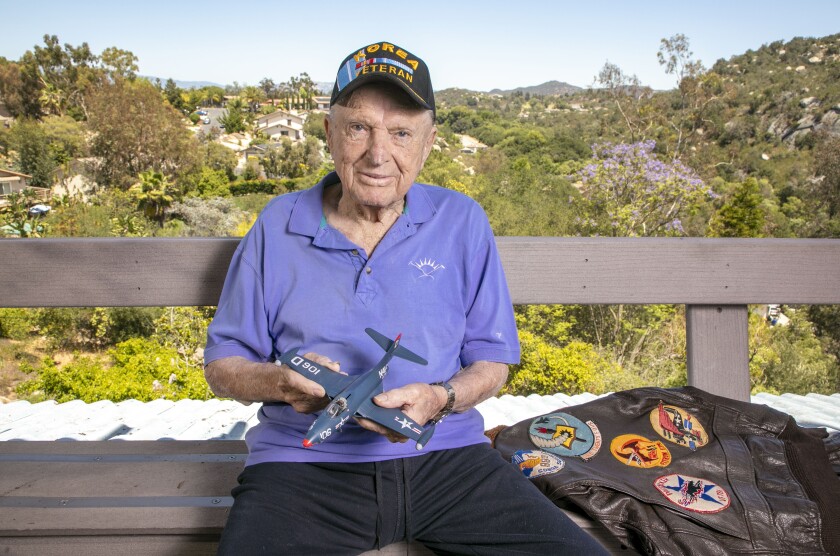Secret hero of the Navy’s greatest solo air battle is from Escondido. Will he finally get his Medal of Honor?
Seventy years ago this fall in the skies over North Korea, US Navy fighter pilot Royce Williams pulled off what many experts say is one of the greatest feats in aviation history. For 35 minutes, he engaged solo in an aerial dogfight with seven Soviet MiG-15 pilots, downing at least four jets before escaping to land his heavily damaged F9F-5 Panther jet on a US aircraft carrier.
Capt. Williams’ aerial heroics have been a legend for decades among pilots coming up through the Navy’s Top Gun school, and the incident was recorded in Soviet Union military history. But no trace of Williams’ daring flight on Nov. 18, 1952, exists in the US military archives.
Rather than acknowledge an air battle that might have had the effect of drawing the Soviets into the Korean War, the US Navy and National Security Agency scrubbed the dogfight from its records and Williams was sworn to secrecy for more than 50 years. As a result, when the nation awarded 146 Medals of Honor to US servicemen for extraordinary value in the Korean War, Williams didn’t make the list.
But this past week, all five members of the San Diego US Congressional delegation joined forces to not only bring Williams’ heroism to the public’s attention, but also to right what they see as a historic wrong. Congress members Darrell Issa, Scott Peters, Sara Jacobs, Juan Vargas and Mike Levin are preparing an amendment to the 2023 National Defense Authorization Act to include the Medal of Honor for Williams.
A signed print by prominent military aviation artist Stan Stokes displayed on a wall in the home of the veteran Royce Williams depicts a US Navy F9F-5 Panther fighter jet, which was the plane Williams flew in a dogfight against seven Soviet MiG-15 fighter jets , seen at top.
(Charlie Neuman/For The San Diego Union-Tribune)
Now 97 and long retired, Williams lives in a scenic mountainside home in Escondido’s Hidden Meadows community. Spinal injuries from a long-ago plane crash in El Centro make it hard for Williams to maneuver around his home, but his memory of the 1952 dogfight remains as fresh today as it was seven decades ago. Asked how it would feel to be awarded the Medal of Honor now, Williams takes a few seconds to consider his answer.
“If it happened, I would be awed,” Williams said on Monday. “I wish my dad could know. It would mean even more to my friends to know that I finally received it.”
Over the past eight years, retired Rear Adm. Doniphan “Don” Shelton of Del Mar tried repeatedly to get the Navy and Department of Defense to award the medal to Williams, but Shelton passed away last October. The newly assembled delegation’s effort, nicknamed “Operation Just Reward,” is now seen as the last chance to get the medal to Williams before he passes away.

A trophy case of military decorations hangs on the wall of E. Royce Williams’ home in Escondido. The one honor that has eluded Williams is the Medal of Honor.
(Charlie Neuman/For The San Diego Union-Tribune)
“Royce Williams is a hero like no other, and his uncommon valor and resolute courage in battle is a history everyone should know,” Issa said in a statement. “His recognition with the Congressional Medal of Honor is overdue and we’re going to get it done.”
But even with the support of the bipartisan delegation, the medal award is no sure thing. Steve Lewandowski, a Navy veteran from Del Mar who assisted Shelton’s efforts for three years, said he believes Williams’ chances of getting the medal are only about 75 percent. But he hopes that will be enough.
“This is it … ‘once more unto the breach.’ It’s a ragtag, zero-resources effort, but it’s the right thing to do. This old man needs to be recognized for this unbelievable dogfight, when quite frankly anyone else would’ve run the other way. He’s the real Top Gun,” said Lewandowski, who is past commander of American Legion Post 416 in Encinitas.

On a warm afternoon, 97-year-old veteran Royce Williams, left, listens as American Legion member and friend Steve Lewandowski speaks about the effort to get Royce awarded the Congressional Medal of Honor for his heroism as a Navy pilot during in the Korean was.
(Charlie Neuman/For The San Diego Union-Tribune)
7v1 encounters
From their early childhood in South Dakota, Williams said he and his brother dreamed of growing up to fly airplanes. They got their wish after enlisting for war duty in the wake of the Pearl Harbor attack in 1941. Williams was still in flight training when World War II ended, but he stayed in the Navy and while finishing up a college degree in Minnesota, the Korean conflict began. After training to fly the F9F-5 Panther jet, Williams shipped overseas and was eventually assigned to provide air support for a fleet of carriers off the North Korean coastal city of Chongjin, about 100 miles south of the Russian city of Vladivostok.
On Nov, 18, 1952, Williams said he and three other Panther pilots were assigned to do combat air patrol along the Yalu River, which separated the North Korean and Soviet territories. At the time, the Soviets weren’t involved in the war and were not seen as a threat, but they had been sending more planes into the skies to protect their airspace.
While climbing through snow clouds below 12,000 feet, Williams said he and his patrol group learned that seven unknown aircraft were approaching at a high elevation. Meanwhile, the captain of the four-plane US patrol experienced an engine problem, so he and his wingman returned to the ship, leaving Williams and his wingman behind. As the unidentified planes flew overhead, Williams recognized them as Soviet MiG-15s.
He and his wingman were instructed to head back toward the fleet and set up an aerial barricade to protect the ships, but Williams and his fellow pilot soon found themselves “bracketed” at 26,000 feet by the MiGs, and four of them began firing at the two Navy planes. Williams’ wingman broke away and safely returned to the fleet, but Williams was trapped.
Suddenly, Williams found himself facing the incomprehensibly long odds of surviving a “7v1″ encounter, meaning seven planes against one. He describes the next 35 minutes as a never-ending battle of strategy and constant maneuvering to avoid being hit from behind, while taking the occasional shot whenever it presented itself He said he was so busy thinking, he never had time to get scared.

Royce Williams, 97, of Escondido holds a model of the Navy F9F-5 Panther jet he flew in an aerial dogfight in the Korean War.
(Charlie Neuman/For The San Diego Union-Tribune)
“I was mentally engaged at the time. A lot of it was awareness of where they were and how I had to maneuver to avoid them. They were taking turns. I decided if I concentrated on shooting them down, then I’d become an easy target. So my initial goal was to look for defensive opportunities when they made mistakes,” he said.
Lewandowski said Williams’ air battle is now known as the longest dogfight in Naval history.
“Before that, the longest one was five minutes,” Lewandowski said. “Even in the most extreme circumstances, pilots know that if you can run, you run. And you only ever train for 3 on 1. To go 7 on 1 is beyond imagining.”
Eventually, Williams ran out of ammunition, and cannon fire from a MiG took out control of his rudder and hydraulics. By that point, only one of the seven original Soviet planes was still in the air with him. He managed to escape by playing cat-and-mouse in the clouds with the MiG all the way back to the protection of the fleet. After he landed, he counted 263 holes in his jet, but he was uninjured.
The story of his dogfight was hushed up immediately, but a couple weeks later Williams was invited to have a private meeting with President-Elect Dwight Eisenhower in Seoul, South Korea. Williams said he shared a cocktail with Eisenhower — who had come to visit the troops to fulfill a campaign pledge — but they never discussed the dogfight since “officially, it never happened.”
Forgotten hero
Williams went on to serve in the Navy an additional 23 years, including flying 110 missions in the Vietnam War. He retired in 1975 with a display case full of medals that include the Silver Star, two Distinguished Flying Crosses and the Legion of Merit with combat “V.” True to his word, he never told anyone about the dogfight — not even his wife, Camilla, or his pilot brother — until the early 2000s, when the Korean War records were officially declassified.
Although the declassified US documents for the Korean War have no record of the dogfight, the air battle was written up in detail in Soviet documents. When the Soviet Union broke up in the early 1990s, those records were released.
Russian military historian Igor Seidov wrote about the dogfight in his 2014 book “Red Devils Over the Yalu: A Chronicle of Soviet Aerial Operations in the Korean War.” He wrote that of the seven MiGs that left Vladivostik that morning, only one returned to base. Four were shot down by a single US aircraft, one plane was shot up and crashed on its way back and the seventh plane was never found.
After reading Seidov’s book, Adm. Shelton launched his campaign for Williams to receive the Medal of Honor. Lewandowski said Shelton gathered signatures of support from nearly 100 Navy, Marine and Army flag officers, as well as resolutions from the American Legion and Distinguished Flying Cross Association. But by not involving Congress members early enough in the process to receive a congressionally awarded medal, Shelton’s efforts ultimately failed.
Lewandowski said there are still hurdles to overcome, as the Navy and Department of Defense have already twice rejected the application. But Lewandowski said he hopes the battle for the medal can now be fought in the court of public opinion and the bipartisan coalition’s support will turn the tide.
“What we’re conveying is that this needs to happen not now, but right now,” Lewandowski said. “He’s the real deal and our country thirsts for heroes. We’ve got to get his award for him before it’s too late.”
Comments are closed.